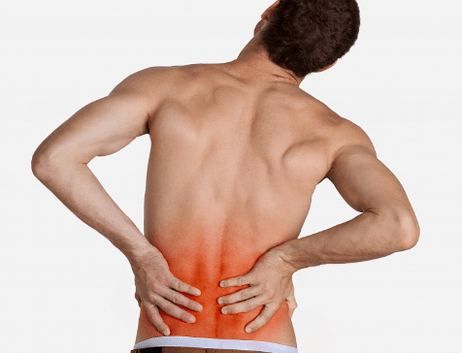Lumbar osteochondrosis is a deformation of the spine in the lumbar region.The disease affects intervertebral discs, cartilage tissues, spinal roots and nerve fibers and causes back pain.
Reasons

The main cause of the disease is the inappropriate distribution of load in the musculoskeletal system.Usually, this happens when walking with high heels, using a bag on one side, with an uncomfortable possession in a dream or in a sitting job.At risk are the elderly, pregnant professional athletes, only born and professionals.
Other causes of lumbar osteochondrosis:
- lesions, bruises, arms fractures, legs, spine;
- damage to the organs of the musculoskeletal system;
- gastrointestinal diseases that cause a deficiency of beneficial substances;
- body tension in prolonged loads;
- psycho -emotional disorders;
- violations of blood flow in the spine;
- inflammation of the musculoskeletal apparatus;
- Internal organ infections and vertebrae;
- rigidity of the joints, displacement of discs;
- protuberance and intervertebral hernias;
- severe poisoning;
- metabolic disorders;
- Posture curvature;
- sedentary lifestyle;
- dehydration;
- unbalanced diet;
- Calcium and oxygen deficiency;
- Overweight;
- bad habits;
- changes related to age;
- Joint diseases.
Lumbar osteochondrosic symptoms
The intensity and nature of the symptoms depend on the stage of the disease.The faster the patient finds signs of lumbosacra osteochondrosis, the more effective the treatment will be.
GENERAL SYMPTOMS:
- Severe pain at the bottom of the back, which can give to the feet, internal organs of the abdomen and the pelvis;
- kidney and sacrum pain;
- fatigue and stress in the lower back and the sacral section of the column;
- Difficulties to move, walk, inclinations and turns of the body;
- Periodic history on the back;
- fatigue after a minor load;
- Crunch on the back, mobility rape, pain in a quiet state;
- numbness of the limbs;
- spasms and cramps in the muscles;
- dizziness;
- weakness and loss of strength;
- Reducing muscle tone and sensitivity.
In men and women, manifestations of lumbar osteochondrosis can vary.Men can have problems with power.Women often suffer from pain in the pelvis.When a deformed spine cannot completely bear the back, the uterus and the appendices experience additional loads and sometimes move around a normal physiological position.
Varieties
The classification of the lumbar spine osteochondrosis consists of several varieties of the disease.For the type of pain syndrome, they distinguish:
Lumbago.Acute symptom.It is expressed by acute bastards and the inability to move.It occurs with muscle cramps, injuries, discs and nerve roots.
Lumbalgia.It is characterized by long -term painful pain caused by hernias, bumps, spondilateros, ligaments and other disorders of the musculoskeletal system.
Sciatica.Powerful pain syndrome in the lumbosacro department, Eradiri in the basin.The pain applies to the sciatic nerve, avoids the normal flexion and extension of the body, prevents me from sitting and standing without pain.
Discogenic lumbar osteochondrosis and radicleopathy are also distinguished.
Lumbar discogenic osteochondrosisIt is accompanied by a loss of sensitivity and numbness not only of back pain, but also of the legs, the buttocks, the hips and the lower part of the abdomen.Sometimes, body temperature increases, weakness, urinary incontinence, the patient loses weight.
Radiculopathyexpressed by numbness of nerve roots and a decrease in human motor skills.Signs: tingling or pain from the entire lower body, deteriorated reflexes, decreased muscle tone and limb joints.
Stages of Lumbar Lumbar Osteochondrosis
Doctors track the dynamics of pathology in four stages:
- First.The symptoms are almost invisible: they are diagnosed in an x line.The stage begins with pathological processes in the cavity deliberately of the excessive disk and the microsets of the fibrous ring.
- The second.The height of the intervertebral discs is reduced, which makes the vertebrae closely.This causes the sliding and displacement of the vertebrae, which is accompanied by pain during the movements.
- The third.It is characterized by the rigidity, instability, the numbness of the body in the coccyx, the lower part of the back and the sacrum.This can be explained by the outstanding vertebrae, proprusions, joint dislocations and osteoarthritis in the spine.
- Four.The most severe degree.The functions of the spine are affected and bone growths are formed (osteophytes).The crops can pinch nerves or damage the integrity of the vertebrae.
The consequences of lumbar osteochondrosis
- Excessive accumulation of salt in the body;
- Hernia development, bump, prolapse of vertebrae and discs;
- chronic radiculitis;
- Paresis and leg paralysis.
Diagnosis
Lumbar osteochondrosis and other musculoskeletal system disorders can diagnose orthopedist, osteopath, neurologist, rheumatologist, manual therapist and surgeon.It is possible to make a precise diagnosis after:
- X -Ray of the spinal column, which shows the condition of bone, cartilage and muscle tissues, as well as ligaments and tendons.
- MIELOGRAPHY - Cephalorrachid fluid studies with dye.With their help, the nerve roots of the spinal cord are studied and evaluated.
For a more detailed exam, doctors use CT and MRI.It can undergo diagnoses in the clinic.

























